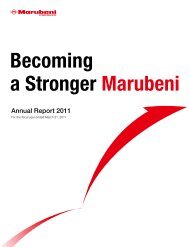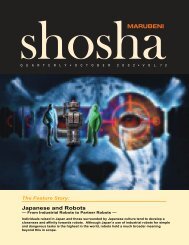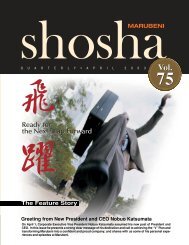Trust Recovery Growth Vitalization - Marubeni
Trust Recovery Growth Vitalization - Marubeni
Trust Recovery Growth Vitalization - Marubeni
Create successful ePaper yourself
Turn your PDF publications into a flip-book with our unique Google optimized e-Paper software.
Risk Management<br />
As emphasized in the “V” PLAN, we have positioned risk management as the key<br />
tool to ensure our earning power and to maximize corporate value. <strong>Marubeni</strong> has<br />
implemented an integrated risk management system based on Value at Risk (VaR) as<br />
part of a ceaseless drive to improve the management of risk.<br />
Through the 1990s, <strong>Marubeni</strong> applied a project-by-project<br />
approach to risk management that made risk-return<br />
performance a function of the aggregate of many individual<br />
management decisions. This approach had the disadvantage<br />
that it did not provide adequate control over risk<br />
diversification. Consequently, <strong>Marubeni</strong> was unable to<br />
appropriately respond to the simultaneous and frequent<br />
materialization of risks in specific segments like during the<br />
currency crisis in Asia.<br />
Based on these experiences, <strong>Marubeni</strong> is shifting its focus<br />
to a management method, which uses “portfolio management”<br />
to oversee the risk in group assets as a whole so as<br />
not to appropriate assets unevenly among certain countries,<br />
industries, or clients.<br />
The basis of portfolio management is in quantifying the<br />
risk of assets for the Group as a whole, including those<br />
held by subsidiaries. In order to do this, assets are categorized<br />
by country, industry, credit rating, and projected<br />
recovery date, and by calculating the Value at Risk (VaR),<br />
“Value at Risk” Assessment Scale<br />
Small asset value Large asset value<br />
Worst case (99%) asset value<br />
Unexpected loss =<br />
Handled with equity capital<br />
Expected asset value<br />
Expected loss =<br />
Reserves<br />
which takes into account dispersion effects and correlations.<br />
By adopting a simulation system that uses an<br />
independently developed computerized statistical model,<br />
we have made it possible to grasp risk levels at a more<br />
minute level than other companies. The method, called<br />
“Integrated Risk Management,” integrates various risk<br />
factors, and monitors them as one risk value.<br />
Based on the risk of the maximum decline in the value of<br />
Group assets as quantified by integrated risk management,<br />
profit after tax less risk asset cost (PATRAC*, which equals<br />
net income – [risk assets x 8%]), the main management<br />
metric in the “V” PLAN, is calculated and used as the portfolio<br />
unit performance indicator.<br />
PATRAC indicates total added value after adjustment for risk<br />
and enables each portfolio unit to achieve maximum returns<br />
for a given level of risk. <strong>Marubeni</strong> is committed to proactive<br />
review and reshuffling of its assets to achieve balanced<br />
growth through the maximization of PATRAC.<br />
*PATRAC = Profit After Tax less Risk Asset Cost<br />
Amount of principal<br />
High possibility<br />
Low possibility<br />
Definition<br />
The largest amount of momentary<br />
loss expected to occur within a<br />
certain time period, based on a<br />
certain probability standard<br />
determined by the decision maker.<br />
= VaR reliability interval of 99%<br />
= Required stockholder capital<br />
= Risk asset


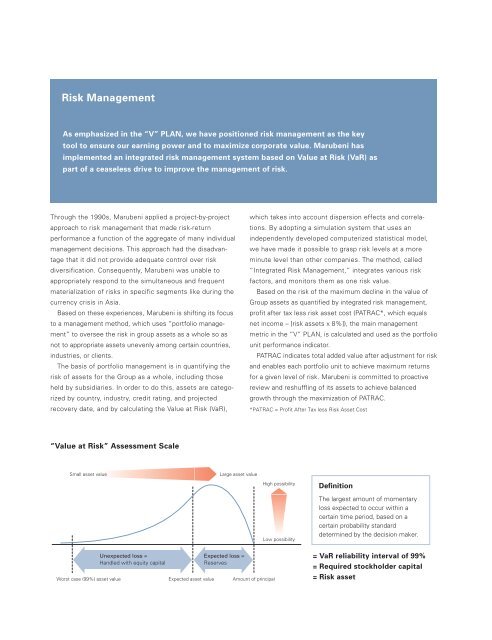
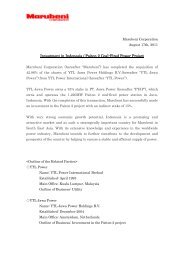
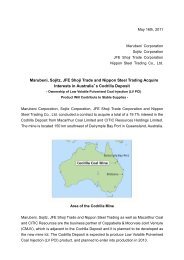
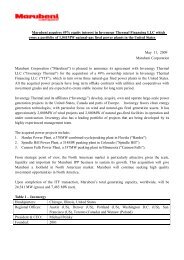
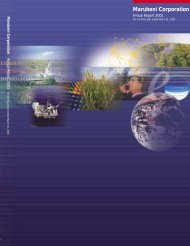
![[Chapter 2] Driving Growth: Expansion Under SG-12 - Marubeni](https://img.yumpu.com/4161147/1/190x248/chapter-2-driving-growth-expansion-under-sg-12-marubeni.jpg?quality=85)
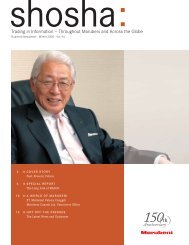

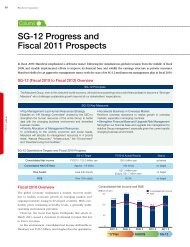
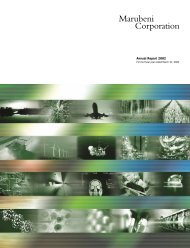
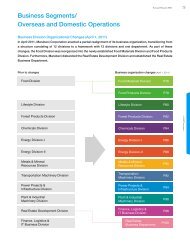
![[Chapter 4] Delivering Growth - Marubeni](https://img.yumpu.com/3464783/1/190x248/chapter-4-delivering-growth-marubeni.jpg?quality=85)
